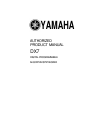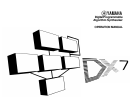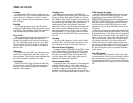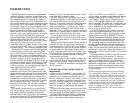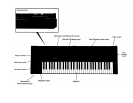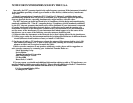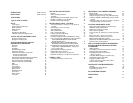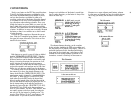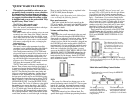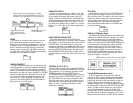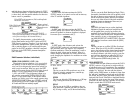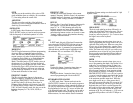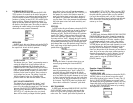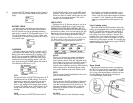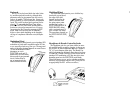INTRODUCTION Inside front cover
PRECAUTIONS Inside front cover
CONVENTIONS 3
"QUICK" BASIC FEATURES 4
SETUP 12
Audio Output 12
External Foot Controller Jacks 12
Breath Controller 12
MIDI Connectors 12
AC Power 12
Installation of Music Rack 12
Additional Technical Installation Notes 13
PLAYING THE FACTORY PRESET VOICES 14
Playing the Internal Voices 14
Playing the Cartridge Voices 14
FUNCTION MODE: SETTING OVERALL
PERFORMANCE PARAMETERS 15
Data Entry 15
Function 15
Poly/Mono 16
Pitch Bend Range & Step 17
Portamento Functions 17
Portamento & Glissando in Poly Mode 18
Sustain: Key Pitch Retain 18
Sustain: Key Pitch Follow 18
Glissando (Key Pitch Retain & Key Pitch Follow) 19
Portamento & Glissando in Mono Mode 19
Fingered Portamento (and Glissando) 19
Full Time Portamento (and Glissando) 19
MIDI 20
Edit Recall 20
Voice Initialize 20
Cartridge Format 20
Battery Check 20
Modulation Wheel 21
Foot Control 21
Breath Control 21
After Touch 21
HOW THE DX7 CREATES SOUNDS 23
Operators 23
Carriers, Modulators and FM 23
Algorithms 24
The relationship between algorithms and the sound 24
Feedback is available in every algorithm 25
Envelopes and Envelope Generators 26
PROGRAMMING VOICES: A TUTORIAL 27
Two basic approaches to creating your own sounds on
the
DX7
27
Programming a voice "from scratch" 27
Voice Initialization 27
What is initialization? 28
How to interpret the display 28
Looking at the initial EG settings 28
Experimenting with the EG 29
Learning to change the operator FREQUENCY settings 31
How to create Frequency Modulation: getting acquainted
with the OPERATOR SELECT OUTPUT LEVEL
and ON-OFF edit features 33
Additional editing features: ALGORITHM SELECT
KEYBOARD RATE SCALING and LEVEL SCALING 38
LFO Modulation: The relationship between the "LFO"
settings and the "MOD SENSITIVITY" settings, and
how to program these 40
Programming the remaining 4 operators 44
Programming velocity sensitivity 45
Naming and storing the newly created voice 45
Edit Recall "Emergency Voice Recovery" instructions 46
EDITING A VOICE 47
Analyzing and keeping a record of voices 48
THE INTERNAL AND CARTRIDGE MEMORIES 49
Memory Protect 49
Storing individual voices to RAM cartridge 49
Saving all 32 internal memory voices to RAM cartridge 49
Loading all 32 ROM or RAM cartridge voices to internal
memory 49
Transfering a single voice from one location to another in
the RAM cartridge or internal memory 49
ADVANCED PROGRAMMING NOTES 51
Playing style and programming of dynamic control 51
Additional envelope considerations 51
Delayed turn-on using the envelopes 51
How to select an algorithm 51
Leam to program by studying how acoustic instruments
work 52
There is more than 1 way to create a pitch 52
Ensemble voices may differ from solo voices 53
Breath controller applications and hints 53
Special effects from [DATA ENTRY] while in PLAY mode 53
Reference sources on FM synthesis 54
MIDI: A STANDARD INTERFACE FOR REMOTELY
PLAYING AND/OR PROGRAMMING MULTIPLE
SYNTHESIZERS 55
MIDI connections 55
Transmitting 32 voices from the Master to the Slave 56
Playing the Slave from the Master 56
Transmitting individual voices from the
Master to the Slave 56
Using DX7 RAM cartridges to save DX9 voices 57
Programming remotely with MIDI 57
Escaping from MIDI control 57
A special setup with two Masters and no Slave 57
More information on MIDI 57
MAINTENANCE AND TROUBLESHOOTING 58
Cleaning 58
Internal Memory Battery Backup 58
If something goes wrong 58
DX SYNTHESIZER GLOSSARY 59
SPECIFICATIONS 63
INDEX 64



